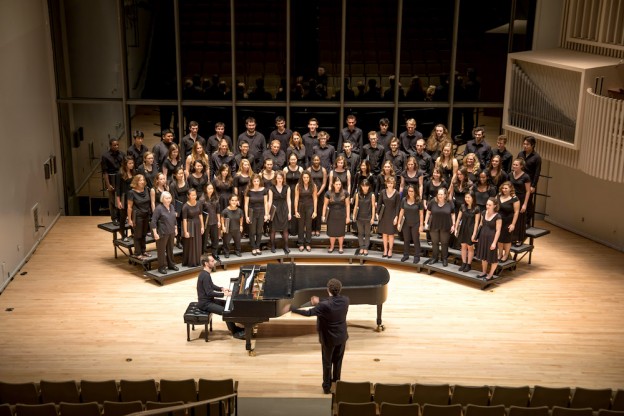In addition to their teaching, Swarthmore professors frequently work on their own, independent projects. Most recently, on April 27, Olivia Sabee, Assistant Professor of Dance, and Thomas Whitman, Daniel Underhill Professor of Music, debuted their collaborative ballet The Wedding Guest at the Kennedy Center in Washington, D.C. The Wedding Guest features Swarthmore alumni musicians, current students as dancers, and Olivia Sabee’s own dance company, Agora Dance.
Professor Whitman composed the ballet’s music. He has previously mainly worked on operas and contemporary dance pieces; this is his first time collaborating with a choreographer on a ballet. Professors Sabee and Whitman considered a number of ideas, before deciding they were interested in environmental themes. Sabee suggested adapting Samuel Taylor Coleridge’s famous poem, The Rime of the Ancient Mariner. As Professor Sabee explains,
“We were talking about all types of different ideas and decided we wanted to portray the natural world, with elements of supernatural…we originally talked about climate change, though that faded from the final piece… [The Rime of the Ancient Mariner] is a piece that can really stand on its on, with no dialogue or acting, although of course we had to pare it down a lot.”
“It’s a great story in terms of environment,” adds Whitman. “The human at the center of it all inexplicably shoots a beautiful creature of nature and gets punished by nature in return, which seemed like a colorful and resonant image. It also has a lot of opportunities to write cool music – there’s the albatross, sea monsters, storms, a calm sea, dance music for the wedding, all these different elements that seem extremely promising.”
“I was intrigued by the idea of writing a ballet with a real, old-fashioned narrative storyline,” adds Whitman. “I like working in collaboration, because it makes it much easier for me to feel like I’m contributing a piece to a larger puzzle. Collaborating with Olivia and my former students, and traveling to D.C. together, was the most pleasant part of the experience.”
Most of the dancers who performed on the program came from Agora Dance, a D.C.-based company co-directed by Professor Sabee. Overall, The Wedding Guest included three professional and seven student dancers.
“The dancers I chose had to have strong ballet skills, but also experience with improv, contemporary dance, and inversion,” says Sabee. “The dancers in this ballet were all chosen for the way they use their arms, which is very important, especially for the albatrosses…My favorite choreographic moment is a pas de deux by the two albatrosses. It’s simple in many ways, very pared down as far as movement goes, but we spent a lot of time working on arm movements to develop birdlike qualities.”
Professor Sabee spent hours watching videos of birds and of water, from waves to whirlpools, to better understand how the dancers could best reproduce the movement of water. She also worked with Swarthmore Associate in Performance Chandra Moss-Thorne, who danced the part of the titular wedding guest, and Tara Webb, who supervises the Swarthmore Theater Department wardrobe and helped design the costumes.
Meanwhile, Professor Whitman watched a number of wedding dances on Youtube in order to compose the festive music for the opening marriage scene. He was also in charge of finding musicians, three alumni and two non-alumni freelance musicians. According to Whitman, “I originally was going to hire freelance musicians in D.C. to play the score, then Olivia decided students should be part of the show. It made no sense to transport D.C. musicians to Swarthmore for rehearsals, so it was better to hire students…I was unsure about asking student musicians, because they would have had to skip a few days of classes. So ultimately I called alumni I have worked with and played with socially. Traveling to D.C. with everyone was wonderful.”
Regarding the presence of professional performers from Agora Dance, Sabee believes “any opportunities to bring students together with professional dancers is really exciting because it really pushes the students to perform more fully, and pushes them physically. We have a great crop of very talented students, and everyone thought it was great working with them.”
The ballet itself, which was part of a larger, 1-hour program, was a major success. Over three hundred people attended in person, with an extra 3,500 watching on livestream. Both professors have expressed delight in working so closely together, and hope to do more collaborations in the future.
Emilie Hautemont ’20

